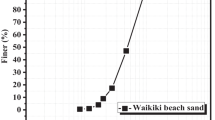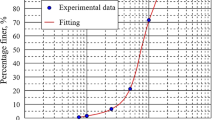Abstract
Microbially induced calcite precipitation (MICP) is used increasingly to improve the engineering properties of granular soils that are unsuitable for construction. This shows MICP technique significant advantages such as low energy consumption and environmentally friendly feature. The objective of the present study is to assess the strength behaviour of bio-cemented sand with varying cementation levels, and to provide an insight into the mechanism of MICP treatment. A series of isotropic consolidated undrained compression tests, calcite mass measurement and scanning electron microscopy tests were conducted. The experimental results show that the strength of bio-cemented sand depends heavily on the cementation level (or calcite content). The variations of strength parameters, i.e. effective friction angle φ′ and effective cohesion c′, with the increase in calcite content can be well evaluated by a linear function and an exponential function, respectively. Based on the precipitation mechanism of calcite crystals, bio-clogging and bio-cementation of calcite crystals are correlated to the amount of total calcite crystals and effective calcite crystals, respectively, and contributed to the improvement in the effective friction angle and effective cohesion of bio-cemented sand, separately.


















Similar content being viewed by others
References
Al Qabany A, Soga K (2013) Effect of chemical treatment used in MICP on engineering properties of cemented soils. Géotechnique 63(4):331–339
Al Qabany A, Soga K, Santamarina C (2012) Factors affecting efficiency of microbially induced calcite precipitation. J Geotech Geoenviron Eng 138(8):992–1001
Bareither CA, Edil TB, Benson CH, Mickelson DM (2008) Geological and physical factors affecting the friction angle of compacted sands. J Geotech Geoenviron Eng 134(10):1476–1489
Chu J, Ivanov V, Stabnikov V, Li B (2013) Microbial method for construction of an aquaculture pond in sand. Géotechnique 63(10):871–875
Consoli NC (2014) A method proposed for the assessment of failure envelopes of cemented sandy soils. Eng Geol 169:61–68
Consoli NC, Prietto DM, Ulbrich LA (1998) Influence of fiber and cement addition on behavior of sandy soil. J Geotech Geoenviron Eng 124(12):1211–1214
Consoli NC, Da Silva LL, Consoli BS, Festugato L (2014) Mohr-Coulomb failure envelopes of lime-treated soils. Géotechnique 64(2):165–170
Das BM (2008) Advanced soil mechanics, 3rd edn. Taylor & Francis, New York
DeJong JT, Fritzges MB, Nüsslein K (2006) Microbially induced cementation to control sand response to undrained shear. J Geotech Geoenviron Eng 132(11):1381–1392
Dupraz S, Parmentier M, Ménez B, Guyot F (2009) Experimental and numerical modeling of bacterially induced pH increase and calcite precipitation in saline aquifers. Chem Geol 265:44–53
Feng K, Montoya BM (2015) Drained shear strength of MICP sand at varying cementation levels. IFCEE 2015, ASCE, pp 2242–2251
Ferris FG, Stehmeler LG, Kantzas A, Mourits FM (1996) Bacteriogenic mineral plugging. J Can Petroleum Technol 35:56–61
Gurbuz A, Sari YD, Yuksekdag ZN, Cinar B (2011) Cementation in a matrix of loose sandy soil using biological treatment method. Afr J Biotechnol 10(38):7432–7440
Ismail MA, Joer HA, Randolph MF, Meritt A (2002) Cementation of porous materials using calcite. Géotechnique 52(5):313–324
Ivanov V, Chu J (2008) Applications of microorganisms to geotechnical engineering for bioclogging and biocementation of soil in situ. Rev Environ Sci Biotechnol 7:139–153
Ivanov V, Chu J, Stabnikov V, Li B (2015) Strengthening of soft marine clay using bioencapsulation. Mar Georesour Geotec 33:320–324
Karol RH (2003) Chemical grouting and soil stabilization. M. Dekker, New York
Lee ML, Ng WS, Tanaka Y (2013) Stress-deformation and compressibility responses of bio-mediated residuals soils. Ecol Eng 60:142–149
Martinez BC, DeJong JT (2009) Bio-mediated soil improvement: load-transfer mechanisms at the micro-and macro-scales. US-China workshop on ground improvement technologies, ASCE, Reston, VA, pp 242–251
Martinez BC, DeJong JT, Ginn TR, Montoya BM, Barkouki TH, Hunt C, Tanyu B, Major D (2013) Experimental optimization of microbial-induced carbonate precipitation for soil improvement. J Geotech Geoenviron Eng 139(4):587–598
Mitchell AC, Ferris FG (2006) The influence of bacillus pasteurii on the nucleation and growth of calcium carbonate. Geomicrobiol J 23:213–226
Montoya BM, DeJong JT (2015) Stress–strain behavior of sands cemented by microbially induced calcite precipitation. J Geotech Geoenviron Eng 141(6):04015019
Montoya BM, DeJong JT, Boulanger RW, Wilson DW, Gerhard R, Ganchenko A, Chou JC (2012) Liquefaction mitigation using microbial induced calcite precipitation. GeoCongress, ASCE, Oakland, California, pp 1918–1927
Montoya BM, DeJong JT, Boulanger RW (2013) Dynamic response of liquefiable sand improved by microbial-induced calcite precipitation. Géotechnique 63(4):302–312
Mortensen BM, DeJong JT (2011) Strength and stiffness of MICP treated sand subjected to various stress paths. Geo-Frontiers, ASCE, Dallas, Texas, pp 4012–4020
Mortensen BM, Haber MJ, DeJong JT, Caslake LF, Nelson DC (2011) Effects of environmental factors on microbial induced calcium carbonate precipitation. J Appl Microbiol 111:338–349
Nemati M, Voordouw G (2003) Modification of porous media permeability, using calcium carbonate produced enzymatically in situ. Enzyme Microb Tech 33:635–642
Ng WS, Lee ML, Tan CK, Hii SL (2013) Improvements in engineering properties of soils through microbial-induced calcite precipitation. KSCE J Civ Eng 17(4):718–728
Rong H, Qian CX, Li LZ (2012) Study on microstructure and properties of sandstone cemented by microbe cement. Constr Build Mater 36:687–694
Stabnikov V, Naeimi M, Ivanov V, Chu J (2011) Formation of water-impermeable crust on sand surface using biocement. Cement Concrete Res 41:1143–1149
Stabnikov V, Chu J, Myo AN, Ivanov V (2013) Immobilization of sand dust and associated pollutants using bioaggregation. Water Air Soil Pollut. doi:10.1007/s11270-013-1631-0
Stocks-Fischer S, Galinat JK, Bang SS (1999) Microbiological precipitation of CaCO3. Soil Biol Biochem 31:1563–1571
The Ministry of Water Resources of PRC (1999) GB/T 50123-1999 standard for soil test method. China Planning Press, Beijing (in Chinese)
Van Paassen LA, Harkes MP, Van Zwieten GA, Van der Zon WH, Van der Star WRL, Van Loosdrecht MCM (2009) Scale up of BioGrout: a biological ground reinforcement method. In: Proceedings of 17th international conference on soil mechanics and geotechnical engineering (ICSMGE)
van Paassen LA, Ghose R, van der Linden TJM, van der Star WRL, van Loosdrecht MCM (2010) Quantifying biomediated ground improvement by ureolysis: large-scale biogrout experiment. J Geotech Geoenviron Eng 136(12):1721–1728
van Paassen LA, Daza CM, Staal M, Sorokin DY, van der Zon W, van Loosdrech MCM (2010) Potential soil reinforcement by biological denitrification. Ecol Eng 36:168–175
Weil MH, DeJong JT, Martinez BC, Mortensen BM (2012) Seismic and resistivity measurements for real-time monitoring of microbially induced calcite precipitation in sand. Geotech Test J 35:1–12
Acknowledgements
This work is funded by the National Key Research and Development Program of China (No. 2016YFC0800208), the National Natural Science Foundation of China (NSFC) (Grant Nos. 51478201 and 51308241) and the China Postdoctoral Science Foundation (Grant No. 2016M600595). The authors are grateful for the financial supports. Special thanks go to the Analytical and Testing Centre at Huazhong University of Science and Technology (HUST) for providing Scanning Electron Microscope. The authors would also like to acknowledge the invaluable cooperation and assistance offered by Prof. Xiao-Yu Zhang’s research team at College of Life Science and Technology, HUST, particularly Mr. Xiao Zhang and Wen-Feng Wang.
Author information
Authors and Affiliations
Corresponding author
Rights and permissions
About this article
Cite this article
Cui, MJ., Zheng, JJ., Zhang, RJ. et al. Influence of cementation level on the strength behaviour of bio-cemented sand. Acta Geotech. 12, 971–986 (2017). https://doi.org/10.1007/s11440-017-0574-9
Received:
Accepted:
Published:
Issue Date:
DOI: https://doi.org/10.1007/s11440-017-0574-9




